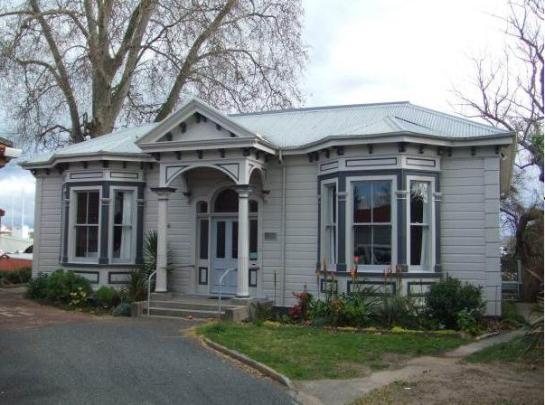Kelvin Rise, currently home to the Gisborne Art Society is part of the Tairawhiti Museum complex, a legacy to Gisborne from the wealthy and well connected Lysnar family who were at the centre of Gisborne politics, business and culture. The story of Kelvin Rise begins with another NZ Historic Places Trust (NZHPT) registered building, Wyllie Cottage. This was built in 1872 for Kate Halbert and James Wyllie, on the site now occupied by the Tairawhiti Museum. The Wyllie’s, with their eight children, moved into the cottage in late 1872 or early 1873 for a brief time, but they did not live there very long. By 1882 the land on which the cottage stood had been surveyed into sections, and a bridge erected across the Taruheru River, opening up Whataupoko to further development. By 5 January 1886 the land and the cottage had been purchased by James Charles Dunlop, an accountant. Dunlop relocated Wyllie Cottage to its present site at the rear of the section next to Stout Street, to enable a new house to be built on the site. Built towards the end of 1886, with a 12-foot stud, the original house had a relatively modest frontage, with one room either side of the doorway, but was of high quality however, since Dunlop had a mortgage of £1300 from the Rev Samuel Williams. Dunlop named the house Kelvin, after his family associations with Glasgow, and the residence became known as Kelvin Rise. Due to financial difficulties, Dunlop sold the house and cottage to William Douglas Lysnar on the 26 August 1898. Lysnar, who was a lawyer, businessman and politician, eventually moved there with his wife, Ida Eleanor Tiffin. The house was extended in 1900, with Lysnar adding more rooms to the elevation facing the river. The lower area was developed into a tennis court and ornamental garden. In 1919, on the occasion of the Lysnars’s daughter Winifred turning nineteen, a ballroom and tower were added to the house. Under Lysnar’s ownership the house became a hub of social activity in Gisborne, with various visiting dignitaries being hosted for banquets and afternoon teas. Lysnar died in 1942 and Winifred Lysnar moved to Okitu. According to the Gisborne Herald, William Lysnar had proposed the idea of the house becoming a museum in a 1922 will, and in 1954 his daughter gave the lower part of the property to the then Gisborne City Council to become Kelvin Park, and sold the house to the council at a low price so it could be turned into a gallery and museum. Kelvin Rise opened in its new role as Gisborne Art Gallery and Museum on 11 June 1955. The house was altered in 1958 to better function as a museum. In 1975 the house was split in two, with the tower and ballroom being moved to The Marina, where it still stands. Kelvin Rise was turned 180 degrees and moved to the edge of the property so that a new purpose built museum could be erected on the Stout Street site. In 1977 Kelvin Rise opened as a studio complex for the use of local artists and is still used by the Gisborne Art Society today. Kelvin Rise has historical significance as part of what was called Kelvin Rise, the home of the Lysnar family. As prominent citizens and cultural patrons, the Lysnars have played a large role in the development of Gisborne, and the on-going use of Kelvin Rise as a studio for the Gisborne Art Society is a reminder of their legacy. The building is a connection to this grand residence and the people and events that took place there. While the building has been extensively modified in terms of its exterior and interior, it still remains a handsome example of Victorian domestic architecture with a number of attractive ornamental flourishes. As part of the Tairawhiti Museum complex, and with its history as a museum and then a studio for local artists, Kelvin Rise enjoys the esteem of the Gisborne community.


Location
List Entry Information
Overview
Detailed List Entry
Status
Listed
List Entry Status
Historic Place Category 2
Access
Able to Visit
List Number
3537
Date Entered
4th April 1984
Date of Effect
4th April 1984
City/District Council
Gisborne District
Region
Gisborne Region
Extent of List Entry
Extent includes part of the land described as Lot 2 DP 2148 (RT GS3A/850) and Lot 13 DP 319 (RT GS2D/379), Gisborne Land District and the building known as Kelvin Rise thereon, and its fittings and fixtures.
Legal description
Lot 2 DP 2148 (RT GS3A/850) and Lot 13 DP 319 (RT GS2D/379), Gisborne Land District
Stay up to date with Heritage this month
